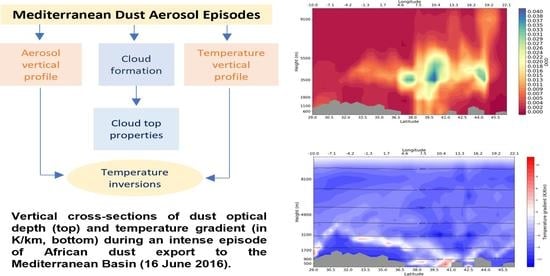Modification of Temperature Lapse Rates and Cloud Properties during a Spatiotemporally Extended Dust Aerosol Episode (16–18 June 2016) over the Mediterranean Basin Based on Satellite and Reanalysis Data
Abstract
:1. Introduction
2. Data and Methodology
2.1. DAEC Identification
2.2. MODIS Data
2.3. MERRA-2 Data
3. Results and Discussion
3.1. Atmospheric Circulation and Regional Dust Loading before and during the DAEC
3.2. Cloud Formation and Properties before and during the DAEC
3.2.1. Cloud Fraction
3.2.2. Cloud-Top Height and Pressure
3.3. The Effect of Dust Transport on Atmospheric Temperature
4. Conclusions
- One day before the beginning of the dust export, a weak cyclonic circulation is established over NW Africa, which is intensified on the subsequent (first) day, favoring the uplifting of DA. A trough at 850 and 700 hPa over the western Mediterranean Basin, and a ridge over the central-to-east basin, intensifying and moving easterly during the evolution of dust export, create a SW wind flow, which transports DA from NE Algeria and Tunisia to the central MB and up to southern Europe;
- There is strong evidence that the evolving Mediterranean dust episode plays a key role in the formation of clouds by providing CCN and IN. Before the DAEC, clear-sky conditions are observed, with few clouds only over the northern parts of the basin, whereas on the first day of the dust episode, mixed-phase clouds are formed over areas with high positive DOD anomalies (values up to 0.9). The formed clouds extend along two northeasterly oriented axes, one over the western MB and a second over the central MB, both being consisted mainly of ice clouds. High CF values (up to 1) are also observed on the second and the third days of DAEC over the areas of MB undergoing dust transport, especially where the dust transport occurs for the first time (given the eastward shift of the African dust transport). However, in these two days (second and third days of DAEC), it is observed that clouds over the areas continuing to undergo dust transport from the first day of DAEC either dissipate or diminish;
- The clouds formed over the Mediterranean dusty regions are mainly high (CTH larger than 10 km) with low cloud-top temperatures (CTT as low as 230 K). Over the areas that undergo continuous dust transport, i.e., for subsequent days, the decrease in CF is associated with reduced cloud height (CTH as low as 500 m) and increased CTT (up to 295 K);
- The dust transport takes place in two atmospheric layers, one near the surface, mostly occurring near the dust source North African areas, and another higher up, in the free troposphere, between 2 and 8 km. Intense temperature inversions (up to 20 K/km) or reduced negative lapse rates (a few degrees/km) are systematically observed below the dust layer. The inversions are more systematically observed within the maritime boundary layer due to the cooler sea surface underlying the dust layer and, also, sporadically over the North African continental areas undergoing continuous dust transport. On the other hand, small negative (reduced) lapse rates are observed in the free troposphere above continental areas (Italian and Balkan peninsulas) experiencing the transport of African dust.
Supplementary Materials
Author Contributions
Funding
Data Availability Statement
Acknowledgments
Conflicts of Interest
References
- Boucher, O.; Randall, D.; Artaxo, P.; Bretherton, C.; Feingold, G.; Forster, P.; Kerminen, V.-M.; Kondo, Y.; Liao, H.; Lohmann, U.; et al. Clouds and Aerosols. In Climate Change 2013: The Physical Science Basis, Contribution of Working Group I to the Fifth Assessment Report of the Intergovernmental Panel on Climate Change; Stocker, T.F., Qin, D., Plattner, G.-K., Tignor, M., Allen, S.K., Boschung, J., Nauels, A., Xia, Y., Bex, V., Midgley, P.M., Eds.; Cambridge University Press: Cambridge, UK; New York, NY, USA, 2013; Available online: http://www.climatechange2013.org/images/uploads/WGIAR5_WGI12Doc2b_FinalDraft_Chapter07.pdf (accessed on 16 December 2021).
- Wang, K.Y.; Liu, C.H. Transport of the Saharan dust air plumes over the tropical North Atlantic from FORMOSAT–3/COSMIC observation. Atmos. Pollut. Res. 2014, 5, 539–553. [Google Scholar] [CrossRef] [Green Version]
- Korras-Carraca, M.B.; Pappas, V.; Hatzianastassiou, N.; Vardavas, I.; Matsoukas, C. Global vertically resolved aerosol direct radiation effect from three years of CALIOP data using the FORTH radiation transfer model. Atmos. Res. 2019, 224, 138–156. [Google Scholar] [CrossRef]
- Korras-Carraca, M.-B.; Gkikas, A.; Matsoukas, C.; Hatzianastassiou, N. Global Clear-Sky Aerosol Speciated Direct Radiative Effects over 40 Years (1980–2019). Atmosphere 2021, 12, 1254. [Google Scholar] [CrossRef]
- Karydis, V.A.; Tsimpidi, A.P.; Bacer, S.; Pozzer, A.; Nenes, A.; Lelieveld, J. Global impact of mineral dust on cloud droplet number concentration. Atmos. Chem. Phys. 2017, 17, 5601–5621. [Google Scholar] [CrossRef] [Green Version]
- Li, R.; Dong, X.; Guo, J.; Fu, Y.; Zhao, C.; Wang, Y.; Min, Q. The implications of dust ice nuclei effect on cloud top temperature in a complex mesoscale convective system. Sci. Rep. 2017, 7, 13826. [Google Scholar] [CrossRef] [Green Version]
- Fan, J.; Yuan, T.; Comstock, J.M.; Ghan, S.; Khain, A.; Leung, L.R.; Li, Z.; Martins, V.J.; Ovchinnikov, M. Dominant role by vertical wind shear in regulating aerosol effects on deep convective clouds. J. Geophys. Res. 2009, 114, D22206. [Google Scholar] [CrossRef]
- Twomey, S. Influence of pollution on shortwave albedo of clouds. J. Atmos. Sci. 1977, 34, 1149–1152. [Google Scholar] [CrossRef] [Green Version]
- Hansen, J.; Sato, M.; Ruedy, R. Radiative forcing and climate response. J. Geophys. Res. 1997, 102, 6831–6864. [Google Scholar] [CrossRef]
- Ackerman, A.S.; Toon, O.B.; Stevens, D.E.; Heymsfield, A.J.; Ramanathan, V.; Welton, E.J. Reduction of tropical cloudiness by soot. Science 2000, 288, 1042–1047. [Google Scholar] [CrossRef] [Green Version]
- Koch, D.; Del Genio, A.D. Black carbon absorption effects on cloud cover: Review and synthesis. Atmos. Chem. Phys. 2010, 10, 7685–7696. [Google Scholar] [CrossRef] [Green Version]
- Kok, J.F.; Adebiyi, A.A.; Albani, S.; Balkanski, Y.; Checa-Garcia, R.; Chin, M.; Colarco, P.R.; Hamilton, D.S.; Huang, Y.; Ito, A.; et al. Contribution of the world’s main dust source regions to the global cycle of desert dust. Atmos. Chem. Phys. 2021, 21, 8169–8193. [Google Scholar] [CrossRef]
- Feingold, G.; Cotton, W.R.; Kreidenweis, S.M.; Davis, J.T. The Impact of Giant Cloud Condensation Nuclei on Drizzle Formation in Stratocumulus: Implications for Cloud Radiative Properties. J. Atmos. Sci. 1999, 56, 4100–4117. [Google Scholar] [CrossRef] [Green Version]
- Hoose, C.; Lohmann, U.; Bennartz, R.; Croft, B.; Lesins, G. Global simulations of aerosol processing in clouds. Atmos. Chem. Phys. 2008, 8, 6939–6963. [Google Scholar] [CrossRef] [Green Version]
- Levin, Z.; Cotton, W.R. Summary. In Aerosol Pollution Impact on Precipitation; Levin, Z., Cotton, W.R., Eds.; Springer: Dordrecht, The Netherlands, 2009. [Google Scholar] [CrossRef]
- Karydis, V.A.; Kumar, P.; Barahona, D.; Sokolik, I.N.; Nenes, A. On the effect of dust particles on global cloud condensation nuclei and cloud droplet number. J. Geophys. Res. 2011, 116, D23204. [Google Scholar] [CrossRef] [Green Version]
- Ginoux, P.; Prospero, J.M.; Gill, T.E.; Hsu, N.C.; Zhao, M. Global-scale attribution of anthropogenic and natural dust sources and their emission rates based on MODIS Deep Blue aerosol products. Rev. Geophys. 2012, 50, RG3005. [Google Scholar] [CrossRef]
- Bullard, J.E.; Baddock, M.C.; Bradwell, T.; Crusius, J.; Darlington, E.F.; Gaiero, D.; Gassó, S.; Gisladottir, G.; Hodgkins, R.; McCulloch, R.; et al. High-latitude dust in the Earth system. Rev. Geophys. 2016, 54, 447–485. [Google Scholar] [CrossRef] [Green Version]
- D’Almeida, G.A. Desert Aerosol: Characteristics and Effects on Climate. In Paleoclimatology and Paleometeorology: Modern and Past Patterns of Global Atmospheric Transport; Springer: Dordrecht, The Netherlands, 1989; pp. 311–338. [Google Scholar] [CrossRef]
- Gkikas, A.; Houssos, E.E.; Lolis, C.J.; Bartzokas, A.; Mihalopoulos, N.; Hatzianastassiou, N. Atmospheric circulation evolution related to desert-dust episodes over the Mediterranean. Q. J. R. Meteorol. Soc. 2015, 141, 1634–1645. [Google Scholar] [CrossRef]
- Engelstaedter, S.; Tegen, I.; Washington, R. North African dust emissions and transport. Earth Sci. Rev. 2006, 79, 73–100. [Google Scholar] [CrossRef]
- Gkikas, A.; Hatzianastassiou, N.; Mihalopoulos, N.; Katsoulis, V.; Kazadzis, S.; Pey, J.; Querol, X.; Torres, O. The regime of intense desert dust episodes in the Mediterranean based on contemporary satellite observations and ground measurements. Atmos. Chem. Phys. 2013, 13, 12135–12154. [Google Scholar] [CrossRef] [Green Version]
- Gkikas, A.; Basart, S.; Hatzianastassiou, N.; Marinou, E.; Amiridis, V.; Kazadzis, S.; Pey, J.; Querol, X.; Jorba, O.; Gassó, S.; et al. Mediterranean intense desert dust outbreaks and their vertical structure based on remote sensing data. Atmos. Chem. Phys. 2016, 16, 8609–8642. [Google Scholar] [CrossRef] [Green Version]
- Chaboureau, J.-P.; Claud, C. Mediterranean cloud system variability inferred from satellite observations. Adv. Geosci. 2006, 7, 246. [Google Scholar] [CrossRef] [Green Version]
- Chéruy, F.; Aires, F. Cluster Analysis of Cloud Properties over the Southern European Mediterranean Area in Observations and a Model. Mon. Weather Rev. 2009, 137, 3161–3176. [Google Scholar] [CrossRef]
- Moulin, C.; Lambert, C.E.; Dulac, F.; Dayan, U. Control of atmospheric export of dust from North Africa by the North Atlantic Oscillation. Nat. Cell Biol. 1997, 387, 691–694. [Google Scholar] [CrossRef]
- Knippertz, P.; Stuut, J.B.W. Mineral Dust—A Key Player in the Earth System; Springer Science & Business Media: Dordrecht, The Netherlands, 2014; pp. 121–147. [Google Scholar]
- Schepanski, K.; Mallet, M.; Heinold, B.; Ulrich, M. North African dust transport toward the western Mediterranean basin: Atmospheric controls on dust source activation and transport pathways during June–July 2013. Atmos. Chem. Phys. 2016, 16, 14147–14168. [Google Scholar] [CrossRef] [Green Version]
- Gavrouzou, M.; Hatzianastassiou, N.; Gkikas, A.; Lolis, C.J.; Mihalopoulos, N. A Climatological Assessment of Intense Desert Dust Episodes over the Broader Mediterranean Basin Based on Satellite Data. Remote Sens. 2021, 13, 2895. [Google Scholar] [CrossRef]
- Bangert, M.; Nenes, A.; Vogel, B.; Vogel, H.; Barahona, D.; Karydis, V.A.; Kumar, P.; Kottmeier, C.; Blahak, U. Saharan dust event impacts on cloud formation and radiation over Western Europe. Atmos. Chem. Phys. 2012, 12, 4045–4063. [Google Scholar] [CrossRef] [Green Version]
- Gong, X.; Wex, H.; Müller, T.; Wiedensohler, A.; Höhler, K.; Kandler, K.; Ma, N.; Dietel, B.; Schiebel, T.; Möhler, O.; et al. Characterization of aerosol properties at Cyprus, focusing on cloud condensation nuclei and ice-nucleating particles. Atmos. Chem. Phys. 2019, 19, 10883–10900. [Google Scholar] [CrossRef] [Green Version]
- Tsarpalis, K.; Katsafados, P.; Papadopoulos, A.; Mihalopoulos, N. Assessing Desert Dust Indirect Effects on Cloud Microphysics through a Cloud Nucleation Scheme: A Case Study over the Western Mediterranean. Remote Sens. 2020, 12, 3473. [Google Scholar] [CrossRef]
- Ioannidis, E.; Lolis, C.J.; Papadimas, C.D.; Hatzianastassiou, N.; Bartzokas, A. On the intra-annual variation of cloudiness over the Mediterranean region. Atmos. Res. 2018, 208, 246–256. [Google Scholar] [CrossRef]
- Barnes, W.L.; Xiong, X.; Guenther, B.W.; Salomonson, V. Development, Characterization, and Performance of the EOS MODIS Sensors. In Earth Observing Systems VIII, Proceedings of the Optical Science and Technology, SPIE’s 48th Annual Meeting, San Diego, CA, USA, 3–8 August 2003; SPIE: Bellingham, WA, USA, 2003; Volume 5151, p. 5151. [Google Scholar] [CrossRef]
- Salomonson, V.V.; Barnes, W.; Masuoka, E.J. Introduction to MODIS and an Overview of Associated Activities. In Earth Science Satellite Remote Sensing; Qu, J.J., Gao, W., Kafatos, M., Murphy, R.E., Salomonson, V.V., Eds.; Springer: Berlin/Heidelberg, Germany, 2006. [Google Scholar] [CrossRef]
- Levy, R.C.; Remer, L.A.; Mattoo, S.; Vermote, E.F.; Kaufman, Y.J. Second-generation operational algorithm: Retrieval of aerosol properties over land from inversion of Moderate Resolution Imaging Spectroradiometer spectral reflectance. J. Geophys. Res. Atmos. 2007, 112, D13211. [Google Scholar] [CrossRef] [Green Version]
- Hsu, N.C. Changes to Modis Deep Blue Aerosol Products between Collection 6 and Collection 6.1. 2017. Available online: https://atmosphere-imager.gsfc.nasa.gov/sites/default/files/ModAtmo/modis_deep_blue_c61_changes2.pdf (accessed on 16 December 2021).
- Mattoo, S. Aerosol Dark Target (10 km & 3 km) Collection 6.1 Changes. Available online: https://atmosphere-imager.gsfc.nasa.gov/sites/default/files/ModAtmo/C061_Aerosol_Dark_Target_v2.pdf (accessed on 17 December 2021).
- Bosilovich, M.G.; Lucchesi, R.; Suarez, M. MERRA-2: File Specification. 2015. Available online: https://gmao.gsfc.nasa.gov/pubs/docs/Bosilovich785.pdf (accessed on 17 December 2021).
- Gelaro, R.; McCarty, W.; Suárez, M.J.; Todling, R.; Molod, A.; Takacs, L.; Randles, C.A.; Darmenov, A.; Bosilovich, M.G.; Reichle, R.; et al. The Modern-Era Retrospective Analysis for Research and Applications, Version 2 (MERRA-2). J. Clim. 2017, 30, 5419–5454. Available online: https://journals.ametsoc.org/view/journals/clim/30/14/jcli-d-16-0758.1.xml (accessed on 16 December 2021). [CrossRef] [PubMed]
- Buchard, V.; Randles, C.A.; da Silva, A.M.; Darmenov, A.; Colarco, P.R.; Govindaraju, R.; Ferrare, R.; Hair, J.; Beyersdorf, A.J.; Ziemba, L.D.; et al. The MERRA-2 Aerosol Reanalysis, 1980 Onward. Part II: Evaluation and Case Studies. J. Clim. 2017, 30, 6851–6872. Available online: https://journals.ametsoc.org/view/journals/clim/30/17/jcli-d-16-0613.1.xml (accessed on 16 December 2021). [CrossRef] [PubMed]
- Randles, C.A.; da Silva, A.M.; Buchard, V.; Colarco, P.R.; Darmenov, A.; Govindaraju, R.; Smirnov, A.; Holben, B.; Ferrare, R.; Hair, J.; et al. The MERRA-2 Aerosol Reanalysis, 1980 Onward. Part I: System Description and Data Assimilation Evaluation. J. Clim. 2017, 30, 6823–6850. Available online: https://journals.ametsoc.org/view/journals/clim/30/17/jcli-d-16-0609.1.xml (accessed on 16 December 2021). [CrossRef]
- Schepanski, K.; Knippertz, P. Soudano-Saharan depressions and their importance for precipitation and dust: A new perspective on a classical synoptic concept. Q. J. R. Meteorol. Soc. 2011, 137, 1431–1445. [Google Scholar] [CrossRef] [Green Version]
- Fiedler, S.; Schepanski, K.; Knippertz, P.; Heinold, B.; Tegen, I. How important are atmospheric depressions and mobile cyclones for emitting mineral dust aerosol in North Africa? Atmos. Chem. Phys. 2014, 14, 8983–9000. [Google Scholar] [CrossRef] [Green Version]
- Dulac, F.; Tanré, D.; Bergametti, G.; Buat-Ménard, P.; Desbois, M.; Sutton, D. Assessment of the African airborne dust mass over the western Mediterranean Sea using Meteosat data. J. Geophys. Res. Atmos. 1992, 97, 2489–2506. [Google Scholar] [CrossRef]
- Varga, G.; Újvári, G.; Kovács, J. Spatiotemporal patterns of Saharan dust outbreaks in the Mediterranean Basin. Aeolian Res. 2014, 15, 151–160. [Google Scholar] [CrossRef] [Green Version]
- Che, H.; Gui, K.; Xia, X.; Wang, Y.; Holben, B.N.; Goloub, P.; Cuevas-Agulló, E.; Wang, H.; Zheng, Y.; Zhao, H.; et al. Large contribution of meteorological factors to inter-decadal changes in regional aerosol optical depth. Atmos. Chem. Phys. 2019, 19, 10497–10523. [Google Scholar] [CrossRef] [Green Version]
- Shi, Z.; Xie, X.; Xin, R.; Li, X.; Liu, Y.; Jing, L.; Liu, X.; Zhisheng, A. Radiative Effect of Mineral Dust on East Asian Summer Monsoon During the Last Glacial Maximum: Role of Snow-Albedo Feedback. Geophys. Res. Lett. 2019, 46, 10901–10909. [Google Scholar] [CrossRef]
- Teller, A.; Levin, Z. The effects of aerosols on precipitation and dimensions of subtropical clouds: A sensitivity study using a numerical cloud model. Atmos. Chem. Phys. 2006, 6, 67–80. [Google Scholar] [CrossRef] [Green Version]
- Barahona, D.; West, R.E.L.; Stier, P.; Romakkaniemi, S.; Kokkola, H.; Nenes, A. Comprehensively accounting for the effect of giant CCN in cloud activation parameterizations. Atmos. Chem. Phys. 2010, 10, 2467–2473. [Google Scholar] [CrossRef] [Green Version]
- Stathopoulos, S.; Georgoulias, A.K.; Kourtidis, K. Space-borne observations of aerosol-cloud relations for cloud systems of different heights. Atmos. Res. 2017, 183, 191–201. [Google Scholar] [CrossRef]
- Pruppacher, H.; Klett, J. Homogeneous Nucleation. In Microphysics of Clouds and Precipitation; Springer: Dordrecht, The Netherlands, 2010; pp. 191–215. [Google Scholar]
- Wang, C.; Jeong, G.R.; Mahowald, N. Particulate absorption of solar radiation: Anthropogenic aerosols vs. dust. Atmos. Chem. Phys. 2009, 9, 3935–3945. [Google Scholar] [CrossRef] [Green Version]
- Kaufman, Y.J.; Koren, I.; Remer, L.A.; Rosenfeld, D.; Rudich, Y. The effect of smoke, dust, and pollution aerosol on shallow cloud development over the Atlantic Ocean. Proc. Natl. Acad. Sci. USA 2005, 102, 11207–11212. [Google Scholar] [CrossRef] [PubMed] [Green Version]
- Koren, I.; Kaufman, Y.J.; Rosenfeld, D.; Remer, L.A.; Rudich, Y. Aerosol invigoration and restructuring of Atlantic convective clouds. Geophys. Res. Lett. 2005, 32, L14828. [Google Scholar] [CrossRef] [Green Version]
- Myhre, G.; Stordal, F.; Johnsrud, M.; Kaufman, Y.J.; Rosenfeld, D.; Storelvmo, T.; Kristjansson, J.E.; Berntsen, T.K.; Myhre, A.; Isaksen, I.S.A. Aerosol-cloud interaction inferred from MODIS satellite data and global aerosol models. Atmos. Chem. Phys. 2007, 7, 3081–3101. [Google Scholar] [CrossRef] [Green Version]
- Ekman, A.M.L.; Engström, A.; Wang, C. The effect of aerosol composition and concentration on the development and anvil properties of a continental deep convective cloud. Quarterly Journal of the Royal Meteorological Society: A journal of the atmospheric sciences. Appl. Meteorol. Phys. Oceanogr. 2007, 133, 1439–1452. [Google Scholar]
- Hatzianastassiou, N.; Katsoulis, B.; Pnevmatikos, J.; Antakis, V. Spatial and Temporal Variation of Precipitation in Greece and Surrounding Regions Based on Global Precipitation Climatology Project Data. J. Clim. 2008, 21, 1349–1370. Available online: https://journals.ametsoc.org/view/journals/clim/21/6/2007jcli1682 (accessed on 16 December 2021). [CrossRef]
- Hatzianastassiou, N.; Matsoukas, C.; Drakakis, E.; Stackhouse, P.W., Jr.; Koepke, P.; Fotiadi, A.; Pavlakis, K.G.; Vardavas, I. The direct effect of aerosols on solar radiation based on satellite observations, reanalysis datasets, and spectral aerosol optical properties from Global Aerosol Data Set (GADS). Atmos. Chem. Phys. 2007, 7, 2585–2599. [Google Scholar] [CrossRef] [Green Version]
- Papadimas, C.D.; Hatzianastassiou, N.; Matsoukas, C.; Kanakidou, M.; Mihalopoulos, N.; Vardavas, I. The direct effect of aerosols on solar radiation over the broader Mediterranean basin. Atmos. Chem. Phys. 2012, 12, 7165–7185. [Google Scholar] [CrossRef] [Green Version]
- Granados-Muñoz, M.J.; Sicard, M.; Papagiannopoulos, N.; Barragán, R.; Bravo-Aranda, J.A.; Nicolae, D. Two-dimensional mineral dust radiative effect calculations from CALIPSO observations over Europe. Atmos. Chem. Phys. 2019, 19, 13157–13173. [Google Scholar] [CrossRef] [Green Version]
- Antón, M.; Valenzuela, A.; Mateos, D.; Alados, I.; Foyo-Moreno, I.; Olmo, F.J.; Alados-Arboledas, L. Longwave aerosol radiative effects during an extreme desert dust event in southeastern Spain. Atmos. Res. 2014, 149, 18–23. [Google Scholar] [CrossRef]
- Gkikas, A.; Obiso, V.; Pérez García-Pando, C.; Jorba, O.; Hatzianastassiou, N.; Vendrell, L.; Basart, S.; Solomos, S.; Gassó, S.; Baldasano, J.M. Direct radiative effects during intense Mediterranean desert dust outbreaks. Atmos. Chem. Phys. 2018, 18, 8757–8787. [Google Scholar] [CrossRef] [Green Version]
- Johnson, B.T.; Heese, B.; McFarlane, S.A.; Chazette, P.; Jones, A.; Bellouin, N. Vertical distribution and radiative effects of mineral dust and biomass burning aerosol over West Africa during DABEX. J. Geophys. Res. 2008, 113, D00C12. [Google Scholar] [CrossRef]
- Sicard, M.; Bertolín, S.; Mallet, M.; Dubuisson, P.; Comerón, A. Estimation of mineral dust long-wave radiative forcing: Sensitivity study to particle properties and application to real cases in the region of Barcelona. Atmos. Chem. Phys. 2014, 14, 9213–9231. [Google Scholar] [CrossRef] [Green Version]
- Schepanski, K. Transport of Mineral Dust and Its Impact on Climate. Geosciences 2018, 8, 151. [Google Scholar] [CrossRef] [Green Version]
- Pérez, C.; Nickovic, S.; Pejanovic, G.; Baldasano, J.M.; Özsoy, E. Interactive dust-radiation modeling: A step to improve weather forecasts. J. Geophys. Res. 2006, 111, D16206. [Google Scholar] [CrossRef] [Green Version]
- Heinold, B.; Tegen, I.; Schepanski, K.; Hellmuth, O. Dust radiative feedback on Saharan boundary layer dynamics and dust mobilization. Geophys. Res. Lett. 2008, 35, L20817. [Google Scholar] [CrossRef] [Green Version]
- Choobari, O.A.; Zawar-Reza, P.; Sturman, A. Feedback between windblown dust and planetary boundary-layer characteristics: Sensitivity to boundary and surface layer parameterizations. Atmos. Environ. 2012, 61, 294–304. [Google Scholar] [CrossRef]
- Yang, S.; Wang, Z.; Huang, X.; Wang, W.; Sheng, L.; Zhou, Y. Meteorological feedback and eco-environmental impact of Asian dust: A simulation study. Atmos. Environ. 2021, 253, 118350. [Google Scholar] [CrossRef]
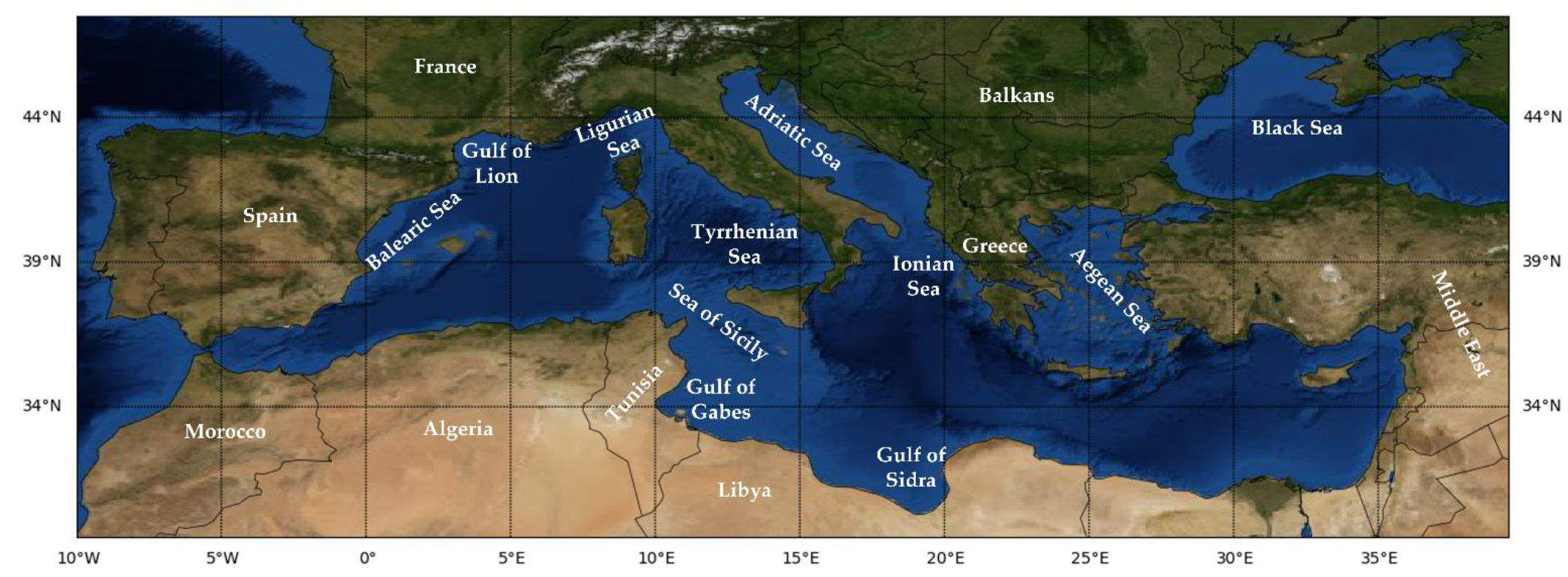
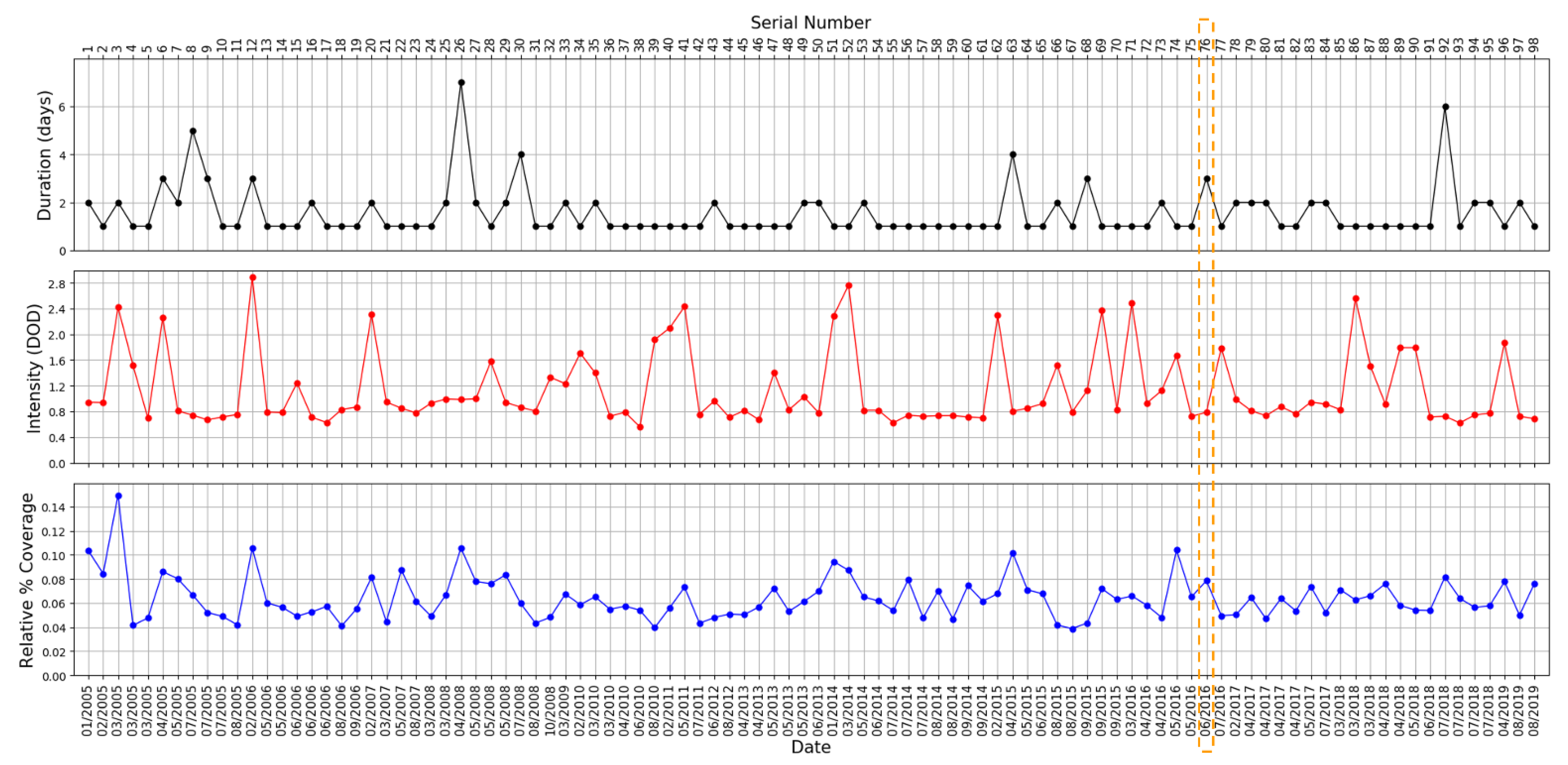

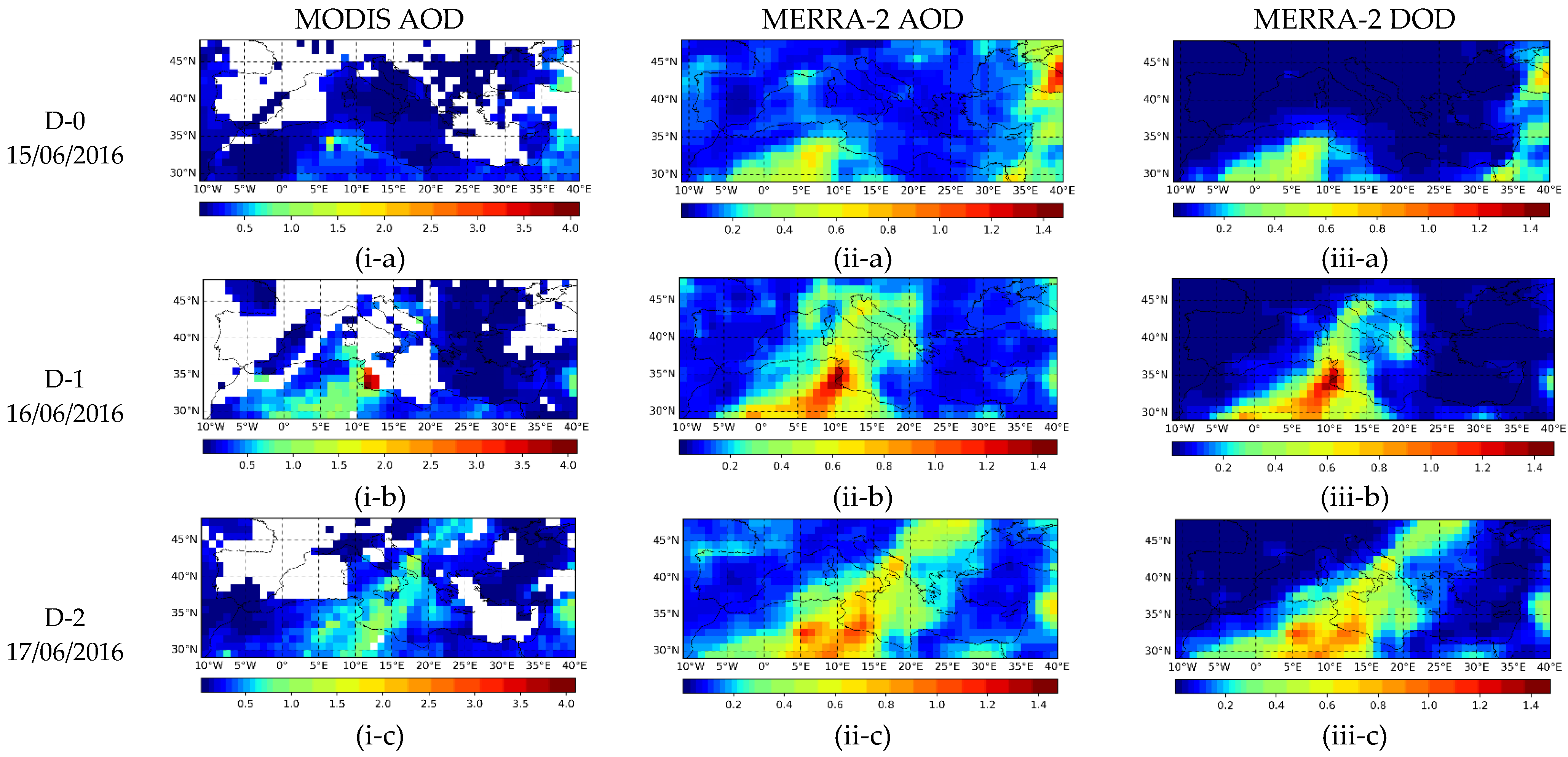

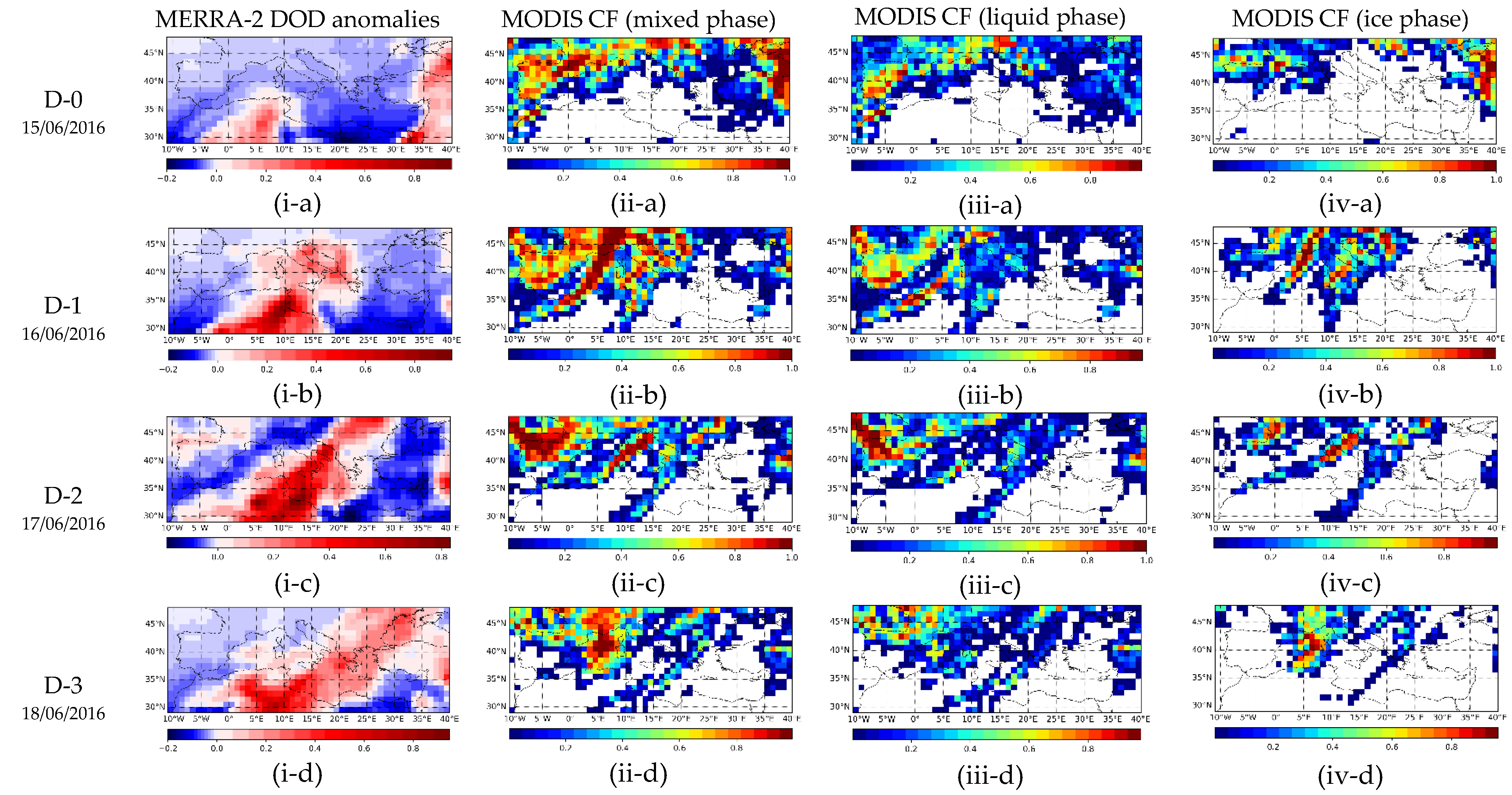

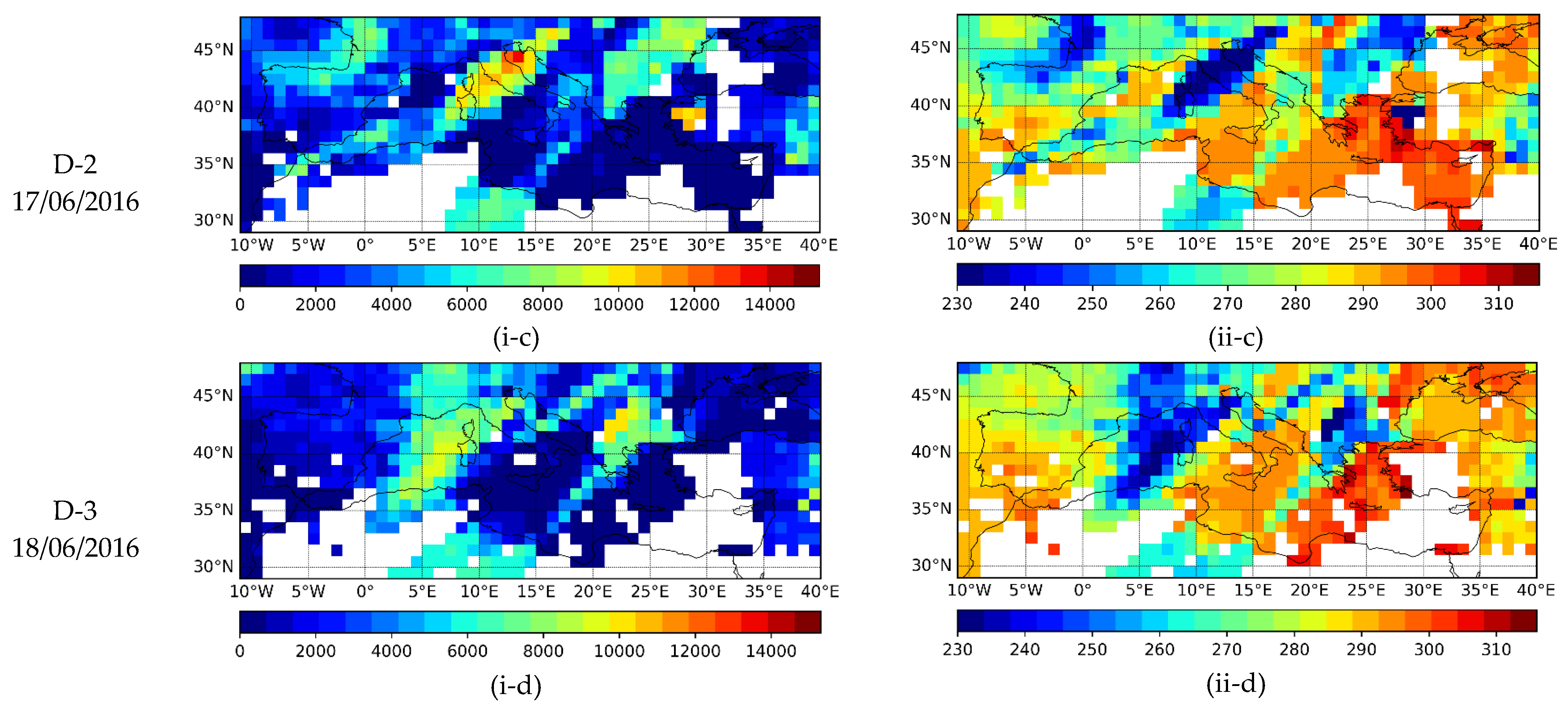
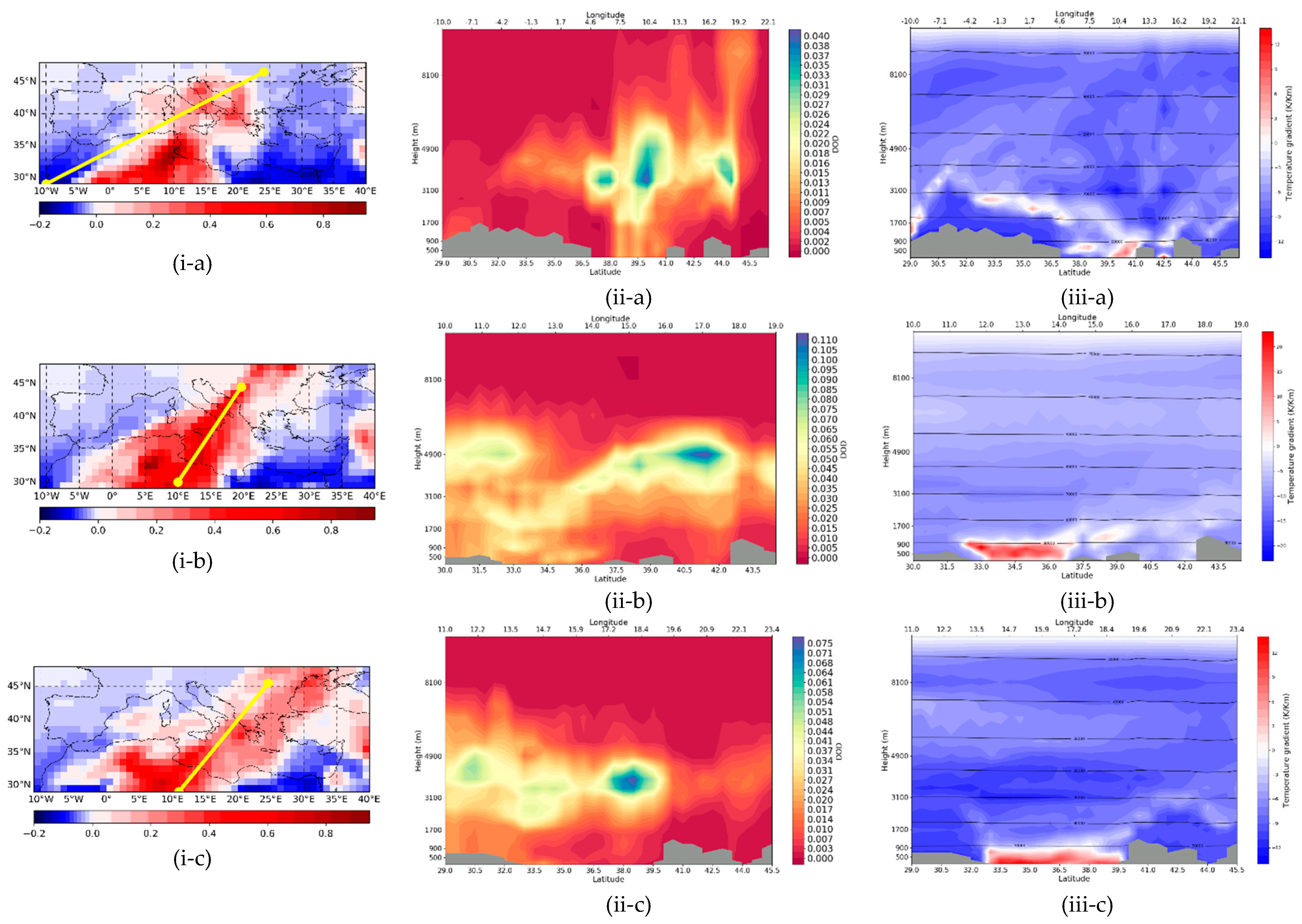
Publisher’s Note: MDPI stays neutral with regard to jurisdictional claims in published maps and institutional affiliations. |
© 2022 by the authors. Licensee MDPI, Basel, Switzerland. This article is an open access article distributed under the terms and conditions of the Creative Commons Attribution (CC BY) license (https://creativecommons.org/licenses/by/4.0/).
Share and Cite
Gavrouzou, M.; Hatzianastassiou, N.; Lolis, C.J.; Korras-Carraca, M.-B.; Mihalopoulos, N. Modification of Temperature Lapse Rates and Cloud Properties during a Spatiotemporally Extended Dust Aerosol Episode (16–18 June 2016) over the Mediterranean Basin Based on Satellite and Reanalysis Data. Remote Sens. 2022, 14, 679. https://doi.org/10.3390/rs14030679
Gavrouzou M, Hatzianastassiou N, Lolis CJ, Korras-Carraca M-B, Mihalopoulos N. Modification of Temperature Lapse Rates and Cloud Properties during a Spatiotemporally Extended Dust Aerosol Episode (16–18 June 2016) over the Mediterranean Basin Based on Satellite and Reanalysis Data. Remote Sensing. 2022; 14(3):679. https://doi.org/10.3390/rs14030679
Chicago/Turabian StyleGavrouzou, Maria, Nikolaos Hatzianastassiou, Christos J. Lolis, Marios-Bruno Korras-Carraca, and Nikolaos Mihalopoulos. 2022. "Modification of Temperature Lapse Rates and Cloud Properties during a Spatiotemporally Extended Dust Aerosol Episode (16–18 June 2016) over the Mediterranean Basin Based on Satellite and Reanalysis Data" Remote Sensing 14, no. 3: 679. https://doi.org/10.3390/rs14030679
APA StyleGavrouzou, M., Hatzianastassiou, N., Lolis, C. J., Korras-Carraca, M.-B., & Mihalopoulos, N. (2022). Modification of Temperature Lapse Rates and Cloud Properties during a Spatiotemporally Extended Dust Aerosol Episode (16–18 June 2016) over the Mediterranean Basin Based on Satellite and Reanalysis Data. Remote Sensing, 14(3), 679. https://doi.org/10.3390/rs14030679







